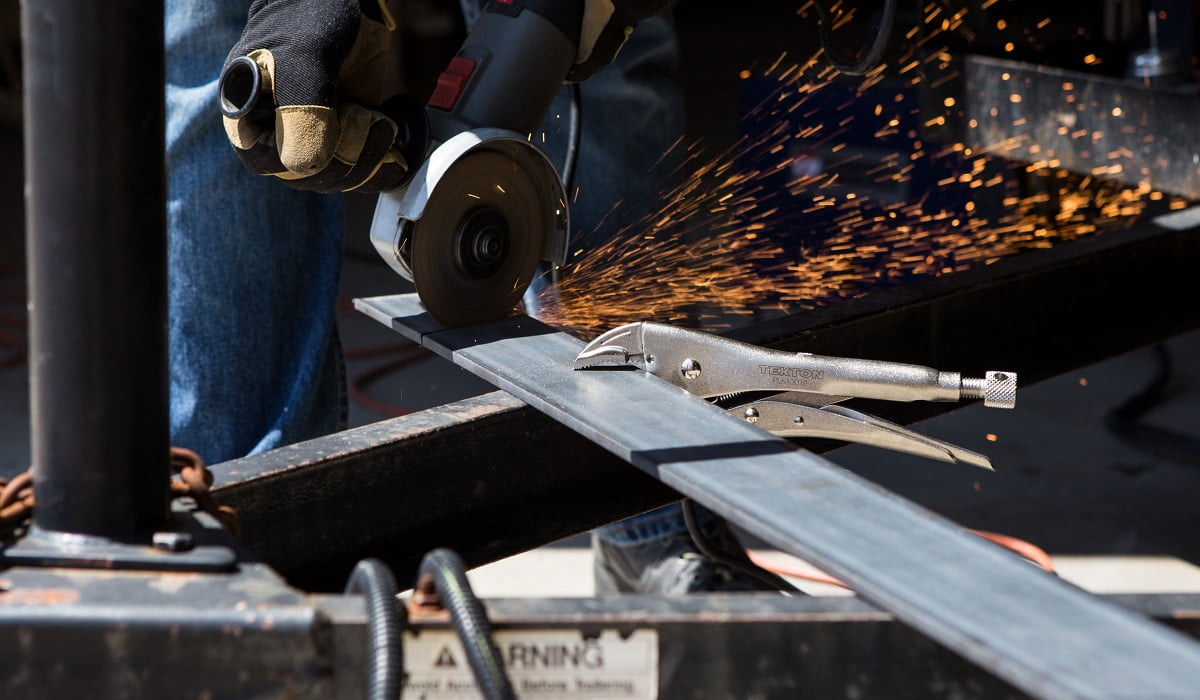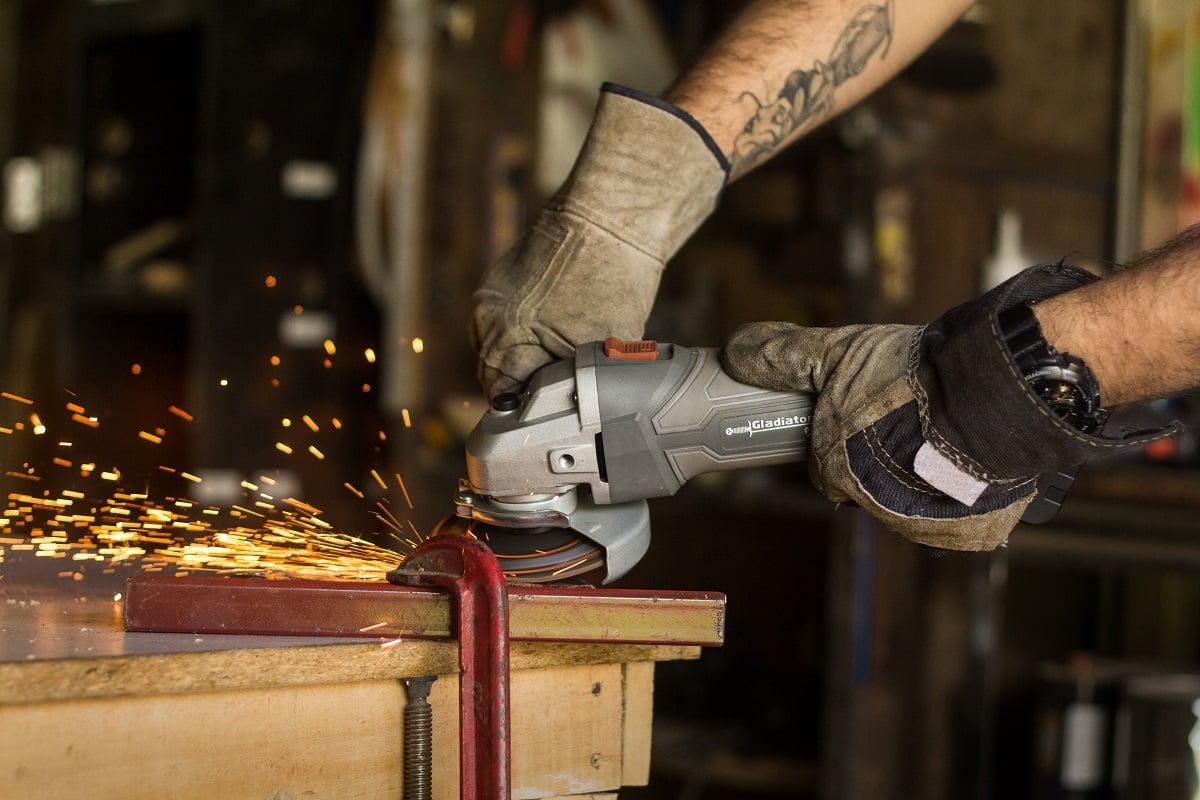An abrasive type 1 or type 27 angle grinder blade can effectively cut through metal of any density. With appropriate cutting techniques and safety protocols, the abrasive blade makes the cutting process extremely safe and efficient.

When tackling woodworking projects, you will inevitably face the conundrum of having to cut through metal. Using a hacksaw for the task can be taxing and time-consuming, and that’s where an angle grinder shows its versatility.
But before you grab your trusty grinder and start working, you should consider a few things about both the power tool and the blade. Let’s explore how you can maximize your efficiency by using the right metal cutting discs and the right techniques.
Cutting Sheet Metal With Angle Grinders

Angle grinders are capable of cutting through even the densest of metals, provided they are fitted with the right disc. And while grinders are usually used for refurbishing and polishing metal materials, you needn’t limit its use to that.
You can use your angle grinder for a variety of metalworking purposes, ranging from making knives to automobile body parts. Each application of this hand-held power tool can be performed with a metal disc that suits the job well.
A good angle grinder and blade combination will leave no room for complaints once you’ve finished with cutting dense steel and even sheet metal. And so, the role of a blade in metalwork cannot be understated. The right kind of disc will make cutting metal or polishing hard edges significantly easier.
The Right Cutting Blade For Metal
The right cutting blade for metalwork is an abrasive cut off disc, also known as a cutoff wheel. These discs have abrasives embedded in the grinding wheel suited for specific metals, such as aluminum cutting discs using aluminum oxide and silicon carbide abrasives. You have the option of using a one-blade-cuts-all disc, but they may turn out to be less effective than metal-specific abrasive discs.
Here is what you should consider when picking the right kind of metal cutting disc for your angle grinder.
1. The Make
Cutting discs best suited for metals are made with resinoid-bonded abrasives, which results in the abrasive materials being fused into the wheel. In short, the abrasives don’t wear off easily as the disc continues to age, enabling you to cut metals with it for longer.
2. The Durability
A cutting disc that breaks midway through a job is less than ideal, which is why the disc should be able to withstand prolonged pressure. To this end, most cutting wheels utilize fiberglass to strengthen them and resist damage when they are used.
3. The Thickness
Thinner discs cut metal faster and produce much less waste. These range from 0.04 to 0.045 inches in thickness and their point-of-contact with the cutting surface is minimal.
On the other hand, thicker discs cut slowly, produce more heat and can lead to the potential discoloration of the metal they cut. Thicker discs are also more durable, so if you’re willing to accept the trade-off, you may be able to work with them. Their thicknesses range from 0.06 to 0.09 inches.
4. The Cutting Depth
You can only fit a disc that can cut no deeper than 2.75 inches in a standard angle grinder. It would be wise to keep that in mind while looking into getting the correct cutting disc.
5. The Blade Type
There are several types of cutting discs designed to cut metal, but the ones best suited for the job are type 1 and type 27. These discs cater to different cutting needs, surfaces, and environments, giving you options when choosing one for your specific task.
Type 1 cutting discs are completely flat and are used to cut metal of all types, including mild steel. The downsides to using these is that they may make it difficult to make a flush cut and may break when used too much.
In contrast, the type 27 discs feature a depressed center that allows your cutting wheel to get closer to the metal. The trade-off with type 27 discs is the high cost and a narrower range of applications.
How To Use An Angle Grinder To Cut Metal
1. Using The Right Tools
Depending on the kind of metal you’re about to work on with an angle grinder, you’ll need an abrasive disc suited for the job. Hobbyists can get away with using an all-purpose disc for the job instead, as it’s more readily available.
You can also use a C-clamp to keep the metal in place before you begin cutting. The less your metal moves as you cut, the better and safer it will be.
Lastly, you can gather protective equipment such as safety goggles and earmuffs before you begin working. Sparks and stray pieces of metal may fly everywhere, and preventing any unfortunate injury as you work is paramount.
2. Check Machine And Cutting Wheel Condition
If you’ve been using the angle grinder habitually, you should check the machine before and after you use it. Over time, the handheld power tool can show wear and tear, and any chances of parts breaking and flying off should be reduced to the best of your abilities.
The same goes for the cutting wheel, and you should ensure twice over that it shows no signs of corrosion. If you see any, address the issue at once, or else you may see shattered chunks of the cutting wheel breaking apart and damaging your project. Worse still, it can lead to serious injury if you don’t don the appropriate safety gear.
3. Affix The Cutting disc
Next, secure the cutting disc properly to the angle grinder and ensure that the disc fits snugly. Type 1 discs need to have the flat side of the nut facing downward against the grinder, while type 27 discs need the protruding part of the nut facing down.
4. Final Checks
You can perform a few final checks before you begin slicing and shaping your metal. These tests ensure that the cutting process remains as safe as possible while giving you the best results.
See if:
- The angle grinder turns on and functions properly
- The metal is secured correctly with the C-clamp
- Your protective gear (safety glasses and face shields) is in pristine condition
- The cutting disc isn’t warped and doesn’t move abnormally
- There are any hazardous objects in your vicinity
Once you’ve marked all these safety points off the checklist, you can move on to the next step of the process.
5. Turn The Grinder On
When you turn the angle grinder on, you should have the guard face your body. The guard will protect your fingers from getting caught in the cutting blade as you work, but remember to be careful!
You may position the machine in a manner that doesn’t require you to cross your arms while you cut. The last thing you’ll want happening while cutting is the grinder slipping from your hands, after all.
6. Cutting The Metal Right
Use the following checklist to ensure that you cut the surface well and prevent the cutting wheel from snapping:
- Keep the cutting edge at a 90-degree angle with the metal
- Be patient and take your time cutting the metal
- Apply no more than moderate pressure on the wheel
- Keep your eyes on the cutting surface
- Don’t leave a cut unfinished, as it can lead to jagged metal edges
Angle Grinder Safety Tips
1. Workplace Safety
As you cut through metal, sparks will fly in all directions and may end up igniting flammables in your vicinity. These sparks can reach up to 1,800 F, which is why you should clear your workplace of anything that can easily catch fire.
These flammables include:
- Wood and sawdust
- Cardboard
- Paper
- Oils and fuel
- Anything that uses aerosol
- Power cables
2. Proper ventilation
Sparks may accompany fumes as well since metal discs can produce a lot of heat as they slice through metal. Keep your doors and windows open and if there’s a strong breeze coming in, position yourself in a way that directs the sparks away from your person.
3. Protective Gear Checklist
You should wear personal protective equipment while working with metal, such as:
- Safety goggles for eye protection
- Earmuffs
- Face shield
- Sturdy gloves
In addition to these, ensure that you don’t wear excessively loose clothing to reduce the risk of it getting caught in the machine. Clothing made of synthetic fibers is a no-go, as it can catch fire much more quickly than any organic piece of clothing. Lastly, wearing a long sleeve shirt to cover exposed skin on your arms is also a good idea to protect you from minor burns.
4. Fire Extinguisher
It’s a no-brainer to have a fire extinguisher within reach and ready to be used in a workshop. Ensure that the extinguisher works properly by testing its functionality regularly and refilling in case it is depleted in a previous use.

Angle Grinder Blade Cuts Metal Conclusion
Thus concludes our guide on angle grinder blades and how they can be used to cut metal. Metal can be quite difficult to slice through, but an abrasive metal cutting disc can effectively do the job.
If you’ve used angle grinders before, you may have noticed that the blade types used for metal are different from the angle grinder blade for concrete. The process for cutting metal requires extra safety precautions with the additional safety hazards that it poses, especially when compared to the process followed with angle grinder discs for wood.
As long as you have the right power tools and safety gear with you, the process is safe and highly efficient. All things considered, you can pick out the right cutting disc for the material of your choice and get to finishing that DIY project of yours!
